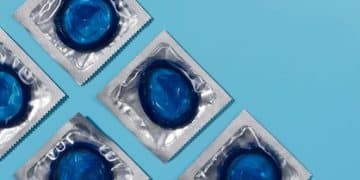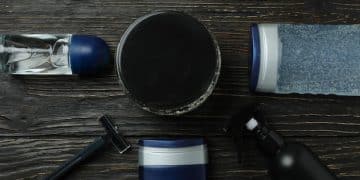Long-Term Effects of Hair Loss Prevention Products: What to Expect After 5 Years
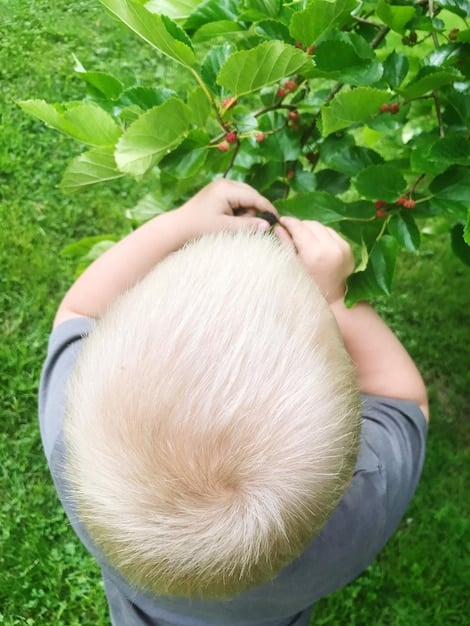
The long-term effects of using hair loss prevention products for 5 years vary, but typically include sustained hair retention, potential side effects that may diminish over time, and dependence on the product to maintain results.
Are you considering using hair loss prevention products for the long haul? Understanding the long-term effects of using hair loss prevention products for 5 years is crucial before committing to such a regimen. This article breaks down what you can realistically expect, both good and bad.
Understanding Hair Loss Prevention Products
Hair loss, or alopecia, is a common concern, particularly among men. Several products promise to slow down or reverse this process. Before diving into the long-term effects, it’s essential to understand what these products are and how they work.
Common Types of Hair Loss Products
The market offers various hair loss prevention products. Two of the most popular and scientifically backed options are Minoxidil and Finasteride.
Minoxidil is a topical solution that stimulates hair follicles, promoting hair growth. Finasteride, on the other hand, is an oral medication that inhibits the production of dihydrotestosterone (DHT), a hormone linked to hair loss.
How These Products Work
Minoxidil works by widening blood vessels in the scalp, which improves blood flow to the hair follicles, encouraging them to grow. It also prolongs the growth phase of the hair cycle. Finasteride targets the hormonal cause of hair loss by reducing DHT levels, thus preventing follicles from shrinking.
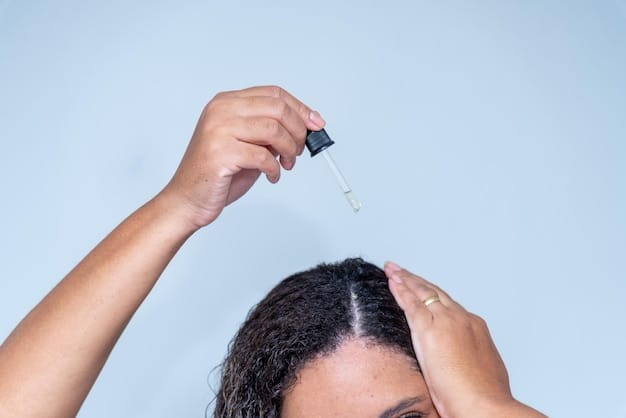
- Minoxidil: Encourages blood flow, stimulates follicles.
- Finasteride: Reduces DHT, prevents follicle shrinkage.
- Other Products: Include shampoos, supplements, and laser devices with varying degrees of effectiveness.
Many people turn to these products hoping for a long-term solution to their hair loss woes. However, it’s important to know that continuous use is generally required to maintain the benefits.
Potential Benefits After 5 Years
Using hair loss prevention products consistently for five years can yield significant benefits. These benefits largely depend on the product and individual response, but some common positive outcomes are observed.
Sustained Hair Retention
One of the primary benefits is the sustained retention of existing hair. Both Minoxidil and Finasteride have been shown to slow down hair loss effectively when used consistently. After five years, users often report maintaining a fuller head of hair compared to what it would have been without treatment.
Improved Hair Thickness and Density
In addition to retaining hair, many users experience improved hair thickness and density. Minoxidil can stimulate hair follicles to produce thicker strands, while Finasteride helps prevent further thinning. Over time, this can lead to a noticeable increase in overall hair volume.
Enhanced Self-Esteem
Hair loss can significantly impact self-esteem and confidence. By effectively managing hair loss, these products can contribute to a more positive self-image and improved psychological well-being. Many individuals feel more confident and socially engaged after seeing visible improvements in their hair.
- Hair Retention: Slows down and maintains hair.
- Thickness: Stimulates thicker strands.
- Self-Esteem: Improves confidence.
While the benefits can be substantial, it’s crucial to manage expectations and understand that results vary. Consistency is key, and individual responses can differ based on factors like age, genetics, and overall health.
Possible Side Effects and How to Manage Them
Like all medications and treatments, hair loss prevention products can have side effects. Some side effects are temporary, while others might persist. Being aware of these potential issues and how to manage them is important for long-term use.
Common Side Effects of Minoxidil
Minoxidil side effects are usually mild but can include scalp irritation, dryness, and unwanted hair growth in other areas. Some users also report an initial shedding phase before seeing improvements. This shedding is generally temporary.
Common Side Effects of Finasteride
Finasteride has a more extensive list of potential side effects, although they are not common. These can include decreased libido, erectile dysfunction, and, in rare cases, depression. It’s important to discuss any concerns with a healthcare provider before starting Finasteride.
Managing Side Effects
Most side effects can be managed with adjustments to the treatment plan. For Minoxidil, using a moisturizing shampoo or reducing the frequency of application can help with irritation. For Finasteride, discussing concerns with a doctor can lead to solutions like lowering the dosage or exploring alternative treatments.
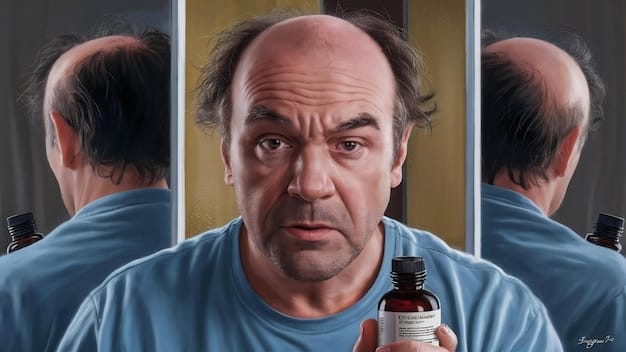
- Minoxidil: Irritation, shedding; use moisturizing shampoo.
- Finasteride: Libido, ED; discuss with a doctor.
- General: Adjust dosage, monitor symptoms.
It’s essential to note that many side effects diminish or resolve over time as the body adjusts to the medication. However, persistent or severe side effects should always be addressed with a healthcare professional.
The Dependency Factor
One of the less discussed, but important, aspects of using hair loss prevention products long-term is the potential for dependency. Understanding this factor can help you make a more informed decision.
The Need for Continuous Use
Both Minoxidil and Finasteride require continuous use to maintain their effects. If you stop using these products, the hair you’ve retained or regrown will likely be lost within a few months. This can be a significant consideration for long-term users.
Psychological Impact of Dependency
The reliance on these products can have a psychological impact. Knowing that you need to continue using them indefinitely to keep your hair can create anxiety or stress. It’s important to be mentally prepared for this commitment.
Alternatives to Reduce Dependency
Some people explore alternative or adjunctive therapies to reduce their reliance on Minoxidil and Finasteride. These might include natural supplements, laser therapy, or hair transplant surgery.
Considering the dependency factor is essential for long-term planning. Weigh the benefits against the commitment required and explore all available options.
Financial Implications Over 5 Years
The cost of hair loss prevention products can add up significantly over five years. Considering the financial implications is an important part of the decision-making process.
Cost Breakdown of Minoxidil and Finasteride
Minoxidil is generally less expensive than Finasteride. A typical monthly supply of Minoxidil can range from $20 to $40, while Finasteride can cost between $50 and $100 per month, depending on whether it’s a brand name or generic version. Over five years, these costs accumulate.
Additional Costs to Consider
In addition to the cost of the products themselves, you may incur other expenses. These can include doctor’s visits, blood tests (especially for Finasteride users), and the cost of shampoos or conditioners designed to support hair growth.
Strategies for Managing Costs
There are several strategies for managing the costs of hair loss prevention products. Using generic versions, buying in bulk, and monitoring your expenses can help you stay within budget. Also, check for discounts or coupons.
- Minoxidil: $20-$40 per month.
- Finasteride: $50-$100 per month.
- Additional: Doctor visits, tests, shampoos.
Being financially prepared can make the long-term use of these products more sustainable. Track your expenses and explore cost-saving options to ensure it fits within your overall financial plan.
Long-Term Health Considerations
Using hair loss prevention products for an extended period can have implications for your overall health. While these products are generally safe, it’s important to be aware of potential long-term health considerations.
Potential Impact on Hormone Levels
Finasteride, in particular, can impact hormone levels by reducing DHT. While this is beneficial for hair retention, it can also affect other bodily functions. Long-term use may lead to subtle changes in hormone balance, although these are often not clinically significant.
Effects on Cardiovascular Health
Some studies have explored the potential effects of Minoxidil on cardiovascular health. While Minoxidil is used to treat high blood pressure at higher doses, the topical application for hair loss has not been definitively linked to significant cardiovascular issues. However, monitoring your blood pressure is advised.
Importance of Regular Check-Ups
Regular check-ups with a healthcare provider are crucial for monitoring your overall health while using these products. This allows for early detection of any potential issues and ensures that the benefits of the treatment outweigh any risks.
- Hormones: Finasteride can affect DHT levels.
- Cardiovascular: Monitor blood pressure with Minoxidil.
- Check-Ups: Regular visits for overall health.
Long-term health should always be a priority. Stay informed, consult with healthcare professionals, and make informed decisions to protect your well-being.
| Key Point | Brief Description |
|---|---|
| ✅ Sustained Hair Retention | Both Minoxidil & Finasteride can effectively slow down hair loss over 5 years. |
| 💊 Potential Side Effects | Minoxidil may cause scalp irritation; Finasteride, decreased libido. Most subside over time. |
| 💸 Financial Commitment | Costs can range from $20 to $100+ monthly; consider generic options & long-term budgeting. |
| ⏰ Continuous Use | Benefits stop if product usage is discontinued; be prepared for a long-term commitment. |
Frequently Asked Questions
▼
Some effects, like scalp irritation from Minoxidil, are reversible with adjustments. However, discontinuing use will likely lead to hair loss resuming. Side effects from Finasteride may persist even after stopping the medication, but this is rare.
▼
Stopping hair loss products after 5 years will typically result in the reversal of any benefits gained. Hair retention and regrowth will gradually diminish, and hair loss will likely resume at its previous rate.
▼
Research into new hair loss treatments is ongoing. Potential future treatments include new topical solutions, improved oral medications, and advanced therapies like stem cell treatments and gene therapy. Stay updated with scientific publications.
▼
Documenting your progress with photos, scalp exams, and hair density measurements can help track your results. Consult a dermatologist for quantitative assessments. Comparing results over time can show both the benefits and potential need for adjustments.
▼
Alternative treatments like laser therapy, natural supplements, and PRP (platelet-rich plasma) may have fewer side effects. However, their effectiveness varies, and they may not be as potent as Minoxidil or Finasteride. Consult a healthcare provider.
Conclusion
Understanding the long-term effects of using hair loss prevention products for 5 years involves weighing the benefits against potential side effects, dependency, financial costs and overall health considerations. With realistic expectations and proper management, you can make an informed decision about integrating these products into your long-term hair care strategy.
